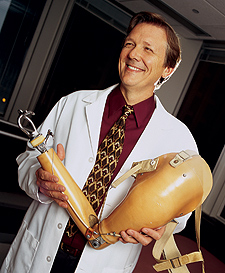|
Bionic Man // Dr. Todd Kuiken // Rehabilitation Institute of Chicago
As a high-school student in Twin Falls, Idaho, Todd Kuiken was fascinated by TV’s The Six Million Dollar Man. “I loved that show,” he recalls, “but I got a little sick of it by the time they had the bionic dog.” The show had legions of fans, but as the leader of a pioneering group of doctors and scientists at the Rehabilitation Institute of Chicago (RIC), Kuiken may be the only one to have turned its sci-fi premise into a real-life strategy for helping amputees. In a press conference this past September, Kuiken and Gregory Dumanian, a plastic surgeon from Northwestern Memorial Hospital, introduced Claudia Mitchell, a former marine from Maryland whose left arm had been destroyed in a motorcycle accident. Now, thanks to Kuiken and his team, Mitchell, 26, had an artificial arm she could control merely by thinking. “Look how with ease I can open and close my hand, and extend and flex my elbow and reach above my head,” she said. “You would be surprised how much you want to and need to do those things when you haven’t been able to for a while.” (For the science behind Mitchell’s prosthesis, see Breakthrough Medicine, page 60.) For Kuiken, that day in September had been more than 20 years in the making. In 1985, while working toward his doctorate in biomedical engineering at RIC and Northwestern, he came across a sentence in a medical journal that suggested doctors try implanting nerves on different parts of the body as a way to electronically control artificial limbs. “That captivated me,” says Kuiken, who is also an MD and self-described gearhead (his premed training included an internship at Boeing). “We usually think about shaping or changing machines and technology to help human-kind. Maybe instead we would change people to allow them to use the technology.” Two decades of work culminated, in June 2005, when Kuiken introduced Jesse Sullivan, a two-arm amputee who could now grasp and lift a glass of water with little visible effort. Fifteen months later, Mitchell was the fourth person, and the first woman, to receive this super-sophisticated mix of surgery and technology. And the Department of Defense, confronted by scores of young military personnel returning from Iraq with missing limbs, have enlisted Kuiken’s team (as well as groups at two other research hospitals) in a $50-million project looking for ways to make artificial limbs more like natural limbs. Born in Champaign, Kuiken, 46, lives in Oak Park with his wife, Lisa Bieman, and their two sons. Despite his remarkable successes, he realizes that the science of prosthetics still has a long way to go. “There is enough left to learn that my grandchildren will still be working at it,” Kuiken says. “From an engineering standpoint, this is the greatest challenge one can imagine: trying to restore the most incredible machine in the universe.” |
|||




